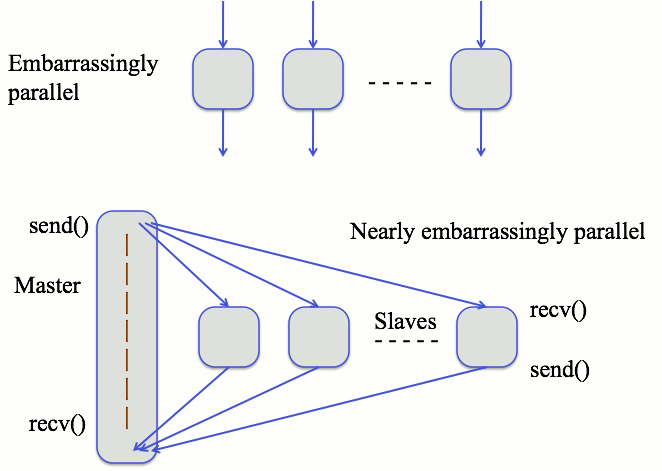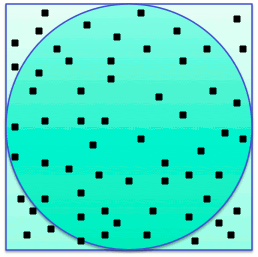Dana Vrajitoru
B424 Parallel and Distributed Programming
Embarrassingly Parallel Algorithms
- Sometimes called naturally parallel algorithms.
- Simplest type of parallel algorithms requiring almost no
communication between the processes.
- Each process can perform their own computations without any need
for communication with the others.
- It may require some initial partition of the data or collecting
the results in the end, but not always.
Ideal Case
- All the sub-problems or tasks are defined before the
computations begin.
- All the sub-solutions are stored in independent memory locations
(variables, array elements).
- Thus, the computation of the sub-solutions is completely
independent.
- If the computations require some initial or final communication,
then we call it nearly embarrassingly parallel.

Variations / Hybrid Systems
- The solutions must be accumulated in a shared data structure -
this requires some coordination at the end.
- Some non-obvious termination condition, such as something being
found. This requires intermediate coordination.
- Not all sub-problems are known initially. Additional overhead
necessary to keep track of the tasks (pool of tasks).
Classic Examples
- Protein folding software that can run on any computer with each
machine doing a small piece of the work.
- SETI project (Search for Extra-Terrestrial Intelligence)
SETI
- Generation of All Subsets.
- Generation of Pseudo-random numbers.
- Monte Carlo Simulations.
- Mandelbrot Sets (a.k.a. Fractals)
Monte Carlo Simulations
- Algorithms that approximate a function using random selections in
calculations.
- Example: approximating pi by comparing the area of a circle to that
of a rectangle enclosing it.
- If r is the radius of the circle, then the area of the rectangle
is 4 r2. That of the circle is pi r2.
The ratio between then is pi/4.
- A MC algorithm can generate n random points inside the rectangle,
count the ones inside the circle, divide by the total, and multiply
by 4.

|
Total points: 65
Points inside the circle: 56
pi ~= 4*56/65 = 3.44615
|
Sequential Algorithm
Count_pt(int N) {
double count_in = 0;
for (i=0; i < N; i++) {
x = randr(-1, 1);
y = randr(-1, 1);
if (x*x+y*y <= 1)
count_in++;
}
return count_in;
}
Pi(N) {
return 4*Count_pt(N)/N;
}
Parallel Algorithm
n = N/no_proc; // assuming N is a multiple of no_proc
Master_count(n) {
Broadcast(n, 0);
my_count = Count_pt(n);
for (i=1; i < no_proc; i++) {
Recv(count, i);
my_count += count;
}
return my_count;
}
Slave_count() {
Broadcast(n, 0);
my_count = Count_pt(n);
Send(my_count, 0);
}
Here the call to the function Master_count replaces the function call
Count_pt in the function PI.
Pseudo Random Numbers
- Technique 1. One process can generate the pseudo-random
numbers and send to other processes that need the random
numbers. This is sequential.
- Technique 2. Use a separate pseudo-random number generator
on each process. Each process must use a different seed. This is
embarrassingly parallel.
- The choice of seeds used at each process is important. Simply
using the process id or time of the day can yield to bad
distributions. One can use the /dev/random device driver in Linux to
get good seeds.
- Technique 3. Convert the linear generator such that each
process only produces its share of random numbers. It is easier to
control but requires more communication.
An Example
A common way to generate pseudo-random numbers is using large primes a and c:
y0 = s; // the seed
y0 = s;
yi+1 = a yi + c
We can convert it to a dependency on a number several positions back.
yi+k = ak yi + (ak-1 +
... + a2 + a + 1) c = ak + c (ak-1)/(a-1)
k Steps
If we denote by A = ak and C = c(ak-1)/(a-1), then
yi+k = A yi + C (*)
computes the kth next number in the sequence.
The master computes p0, p1, ..., pk-1
using the simple formula, then sends them to each process.
Each process generates its own random numbers from the seed received
from the master using (*).




